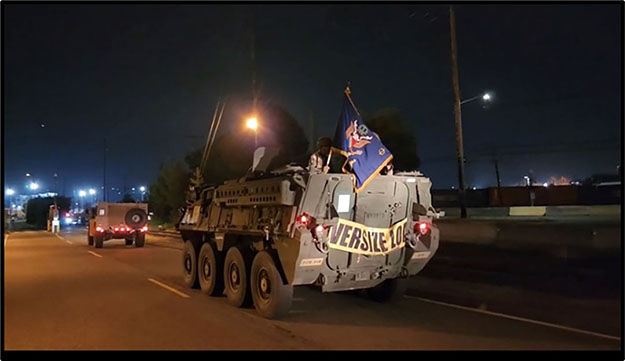Moving is complex, especially when it involves a Stryker Brigade.
In September, the Army announced that Joint Base Lewis-McChord's 2-2nd Stryker Brigade Combat Team, 7th Infantry Division, will deploy to Korea as part of a regular nine-month, unaccompanied rotation of forces in support of the U.S. commitment to the Republic of Korea.
Notified about a year ago of the likely deployment, brigade leadership began preparing.
"We consider ourselves a ‘Team of Teams,'" began Maj. Jeffrey Wismann, the brigade's operations officer. "In my role, I am charged with the synchronization of the brigade's efforts to get us there."
Underscoring the sense of teamwork synchronization, Wismann relies on the logistics experts on the brigade's staff and from 7th ID's headquarters staff.
He stated that 2-2 SBCT has also received proactive outreach from the Surface Deployment Distribution Command (SDDC), which works with JBLM's 593rd Expeditionary Sustainment Command and the Port of Tacoma.
"All of this combines to make JBLM a hub for strategic force projection anywhere in the Indo-Pacific (INDOPACOM) region," noted Wismann.
To prepare for and make the move, he added that the Army uses a system to assess the readiness of personnel, equipment, and training.
For soldiers this is a review of their Soldier Readiness Packet (SRP) to include medical, finance, family care plan to ensure that personnel are deployable.
As for the brigade's equipment, "we strive to maintain our equipment with a ‘Fight Tonight' readiness level," continued Wismann. "This is no easy task with over 400 pieces of ‘rolling stock' to deploy."
Preparations for the move begin in the brigade's motor pools, then progress to the Installation Transportation Division (ITD) where a team makes final equipment preparations followed by the registering of all vehicles and containers before entry into a global tracking system.
"They do pre-inspections on installation to make sure our vehicles and containers are seaworthy," said Wismann.
"We convoy or line haul all our deployment equipment to the Port of Tacoma where the team from SDDC takes over to ensure everything gets loaded properly on vessels."
Some of the challenges Wismann and his teams have faced are what he called "experiential learning."
"It's been six years since JBLM deployed a full brigade. While the infrastructures exists to make the move, the installation and our team had to relearn all of the systems," said Wismann.
"I think everyone has done a phenomenal job to make our deployment a success."
Once a part of the Korea Rotational Force, Wismann and his team will validate all the planning assumptions that were used for the armor brigade the 2-2 Stryker Brigade is replacing.
"As the first Stryker Brigade in Korea to deploy as the Korea Rotational Force, we have an obligation to set the precedent for Strykers on the Korean Peninsula," concluded Wismann.
"Our success will set the conditions for the future success of every subsequent Stryker Brigade ... and we hope Strykers are welcome and invited to operate on the Peninsula for the foreseeable future."





Read Comments